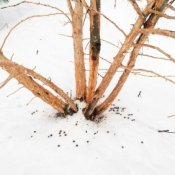 Hungry animals can make a meal out of your trees and plants during the winter months pretty quickly. Sometimes the damage is obvious-plants are fine one day, only to appear damaged or even disappear completely the next. Other times the damage isn't noticeable until spring, when your trees and plants fail to grow and flourish. Here are some steps you can take this fall to prevent animals from damaging your plants over winter.
Hungry animals can make a meal out of your trees and plants during the winter months pretty quickly. Sometimes the damage is obvious-plants are fine one day, only to appear damaged or even disappear completely the next. Other times the damage isn't noticeable until spring, when your trees and plants fail to grow and flourish. Here are some steps you can take this fall to prevent animals from damaging your plants over winter.
Deer typically damage plants in two ways: by rubbing young trees with their antlers (during the fall rut), or by browsing on the leaves and stems of woody plants. Although browsing happens year round, most of the damage occurs in the winter, when a hungry deer can consume up to 4 pounds of woody twigs in a day. Signs of deer browsing include stems that have been snipped off cleanly with a straight edge. Despite what gardening books and catalogs tell you, there is no such thing as a completely "deer resistant" plant. When deer are hungry and food is scarce, all plants are susceptible to browsing.
Fortunately, deer are very resistant to certain smells. If the deer population is small in your area, consider experimenting with some of the smelly repellent sprays on the market, or try hanging mesh bags filled with deodorant soap on the branches of your trees and shrubs. In more populated areas, small plants and shrubs should be protected with individual wire cages.
Rabbits injure plants by nibbling on small twigs and buds or by feeding on the shoots and stems near the ground. They are particularly fond of feeding on tender bark. Signs of rabbit damage include small stems snipped off cleanly, at a 45 angle. As with deer, rabbits have a strong aversion to certain scents. In most cases, the repellents used to deter deer will also work on rabbits. These repellents are not a permanent solution (they need to be reapplied after wet weather), but in most cases they work long enough to "train" rabbits to move on in search of food.
One of the best ways to protect plants from rabbits is to erect a fence that is 18 to 24 inches tall, and buried 2 to 3 inches into the soil. Just make sure that when the snow starts to pile up you keep a path shoveled around the fence to prevent the rabbits from using the height of the compacted snow as a means to jump over the fence (I learned this the hard way one year with my raspberry bushes). Trunks and stems of individual plants can be protected with a cylindrical collar made from small gauge wire mesh (often called hardware cloth). Cut the wire so that it is a few inches wider than the diameter of the trunk and make the collar at least 2 or 3 feet taller than your average snow depth, so you can sink it into the ground to prevent them from tunneling underneath. Use 2 to 3 stakes and some wire to secure it in place.
Rodents attack trees and plants both above and below the ground. Like rabbits, they are capable of gnawing off enough bark to severely damage (even kill) your trees and shrubs. Below ground (and under mulch), they construct feeding tunnels that lead to the roots and bulbs of your plants. The same type of wire collars used to protect plants from rabbits are an effective means to deter small rodents-as long as the mesh is 3/4 inch gauge or smaller. If you need to protect some extra special perennials and bulbs (e.g. rare, expensive, or sentimental), line their planting holes with the wire mesh. In the fall, clean up garden debris thoroughly and wait until the ground is frozen before you apply mulch, keeping it at least a few inches away from the base of your plants.
The yellow-bellied sap sucker is the most likely member of the woodpecker family to cause serious damage to backyard trees. Although they also feed on other tree species, pine, apple, maple, and birch trees are their favorites. Sap suckers cause damage by repeatedly pecking at insects, sap, and the inner bark of the same tree. The damage appears as holes with a regularly spaced pattern, either a horizontal circle around the trunk or vertical side-by-side rows. After repeated attacks to the same area, large patches of the bark may be removed and the area above the damaged portion of the tree may die.
To discourage sap suckers and other woodpeckers from damaging trees, wrap hardware cloth or burlap around the area being attacked. Some gardeners have also found success by smearing the bark with a commercial stick repellent, such as Tanglefoot bird repellent. Even though it's non-toxic and biodegradable, it should be used with caution, as bird species that are not causing damage may also become stuck in it.
This page is about homemade deer repellents. Although proper fencing is the best way to deter deer, there are some things that fend them off.